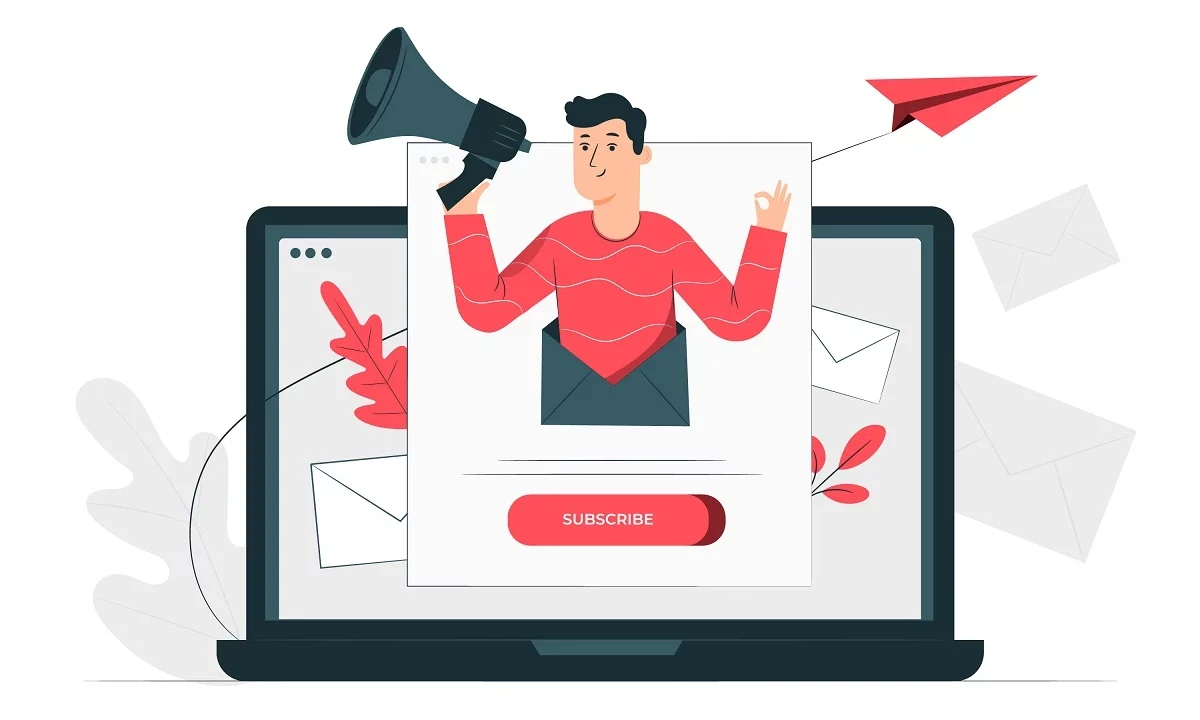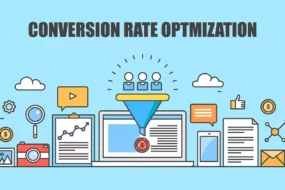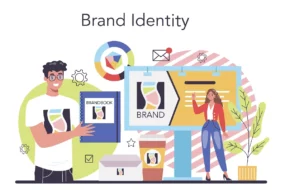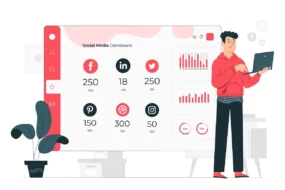
If you’ve been eyeing marketing strategies to help your business grow, you’ll have seen one, in particular, again and again—email marketing! Now, you’re probably wondering, how do I get the know-how on email marketing for beginners?
First things first, let me dispel any doubts you have about the reliability of this method for your business growth. If you believe the days of email are long gone, you couldn’t be more wrong!
The proof? It’s in the pudding, and the pudding is the actual metrics! As of 2020, email marketing has recorded a conversion rate of 15.11%. However, your results depend on going about your email campaign the right way. Hang tight as I walk you through the ultimate guide to email marketing!
What is Email Marketing?
Email marketing is one of the most compelling digital marketing strategies to reach prospects and customers alike! The premise is simple. You send out commercial emails to subscribers who have given explicit permission to receive communications from you.
Then depending on how well you wield this powerful tool, you can turn prospects into paying customers. What’s more, you can acquire a loyal fanbase from a posse of one-time buyers!
Email campaigns are multi-dimensional. They can be used to inform, push sales, and build a brand community, and all the power lies with you!
Different Types of Email Marketing
One aspect, in particular, that makes e-mail marketing so effective is its versatility! Think about it; do you like being bombarded by the same newsletters over and over again? Neither do I, and nor will your subscribers!
Here are some catchy email marketing ideas that can give your digital marketing strategy the boost it needs!
- Newsletters: keep subscribers up-to-date on company ongoings
- Welcome Emails: give prospects a warm reception
- Dedicated Emails: use these to focus on only one product, service, event, and so on
- Lead Nurturing Emails: promotional emails based on buyer persons and needs
- Review Requests: show customers you value their feedback
- Re-engagement Emails: subscribers may forget you, but ensure they know you never forget them
- Brand Story Emails: evoke emotional responses through effective story-telling
The Benefits of Email Marketing: Why Should You Use It?
“Is email marketing dead?” That’s a question you’re sure to come across as you learn more about email advertising. Well, I’m here to tell you the answer is no, far from it!
Not sure you believe me? Consider how you feel after checking out why this strategy is so efficient in this email marketing for beginners guide!
- Top Communication Channel: People spend 5 hours a day checking emails!
- List Ownership: You face no risk of losing subscribers due to account suspension or deletion.
- Better Conversion: Emails have an average value order three times higher than social media.
- Increase Website Traffic: Emails are an easy way to direct traffic to your site and improve SEO!
Email Marketing for Beginners: What Should You Know Before Getting Started?
Here’s a little tip from me: consider a subscription to your email list like an invitation into a prospect’s life. You want to interact, but you don’t want to intrude!
Much like you, your subscribers likely receive dozens of newsletters, pitches, and advertisements a day. So to avoid seeming like a nuisance, ensure your emails are professional and exude good manners.
I know it can be disheartening when a marketing email doesn’t get the responses you desire. However, that’s all the more reason to show your subscribers you’re not like the millions of other brands out there.
Be mindful of customer requests and show them you truly care! That’s the golden rule to successfully learning email marketing for beginners.
Email Marketing for Beginners: A Step-by-Step Rundown
A targeted email marketing plan isn’t one you can hatch overnight. That’s something I can tell you right off the bat! Instead, it is one that requires a balance of strategy and execution.
A lot goes into making an email stand out from the rest as the crème de la crème. However, there’s no reason for you to worry whatsoever! I’ll be giving you the complete rundown of how to do email marketing in this email guide for beginners.
1. Set Goals You Can Measure
Analyze just what you hope to achieve from your email campaign. That’s the first step in email marketing for beginners. For instance, are you hoping to drive sales, or are you looking to increase email engagement?
Once you know the purpose behind a campaign, it’s time to set some measurable goals! Of course, these are entirely up to you to decide. Even so, I’d thought I’d give you a few examples of what a good goal looks like:
- Increase your email list by 10% each quarter
- Raise your open rate by 20% in 6 months
- Measure sign-ups for your product or service to drive conversion rates
- Try a new A/B test for every campaign with winning elements
The key to setting a realistic yet good goal is to keep it simple and clear! The easier a goal is to measure, the easier it is for you to see how your campaign improves over time.
Align Your Team with Goals and Responsibilities
Is there anyone besides you that will be actively involved with your email campaign? If so, it is best to familiarize them with the details from the get-go!
Consider assigning ownership of points to your team as a priority! I guarantee that this will make your workflow that much smoother, leaving no room for future surprises!
Answering these questions might help you get a headstart on this process:
- Who is in charge of collecting content?
- Who writes the copy?
- Where will you get the creative and art assets for your emails? Do you have a designer on board, or will you hire a freelancer?
- Who is responsible for reviewing the test emails?
Trust me when I say knowing the answers to the questions beforehand will save you valuable time in the future! Remember, time means efficiency, especially in email marketing for beginners.
2. Create an Email Marketing Campaign
Are you still wondering why an email campaign should be a part of your digital marketing strategy? If so, the answer lies in the stats! 52% of people check their email every few hours, even while at work!
So it is evident people care about their inboxes even when busy. As such, successful email marketing lies in pervading inboxes with content users will appreciate!
As such, drafting a list of genuine subscribers is a critical step in email marketing for beginners. Setting up an email subscription banner or form on your website can help create the initial buzz. Getting actual sign-ups, though, is another matter.
Of course, there will be people who sign up for your content simply because it interests them. However, here’s a little trick of the trade to help you rope in others, too: offer an incentive!
What you offer as an incentive is entirely up to you. Free downloadable assets, ebooks, white papers, or even simple updates, the choice is yours! That said, you may want to give some consideration to your buyer persona.
Another fun way I learned to collect email ids is through contests and giveaways!
However, what if you already have an email list? Well, there are still a few things you could do too!
Start a Re-Engagement Campaign
You may already have an email list in hand. However, that doesn’t mean you can’t prune your list. In fact, this is something I recommend doing every now and then to improve your metrics!
So how do you prune your list? Through simple re-engagement emails! Essentially, these emails help reignite interest in inactive users for your content.
As such, they work one of two ways. Either they encourage users to re-engage with your content, or they motivate them to unsubscribe.
Granted, the latter may not feel the best. However, take it with a pinch of salt as you learn email marketing for beginners. From personal experience, I can tell you one active user is worth a dozen who don’t open your emails!
What is a Hard Bounce in Email Marketing?
In simple terms, a hard bounce is an email that permanently fails to deliver. One reason this may happen is that the email address itself is invalid. For instance, the domain name may be incorrect, or it may even be fake.
Whatever the reason, hard bounces are something you should take care of immediately. There’s nothing more dangerous to deliverability in email marketing for beginners than a series of hard bounces!
Why? Well, because they put you on the radar of spam filters! After working hard on crafting your campaign, the last thing you want is to end up in a subscriber’s spam folder. So ensure your email list is in the best of health always!
3. Choose an Email Template or Create Your Own
Next comes another big decision in creating a successful email marketing campaign. Are you going to build each from scratch or rely instead on customizable pre-made templates?
Now, if you’re someone like me, you may prefer having control over every step of the process. However, since you’re learning email marketing for beginners, you’ll be better off choosing a pre-made template.
For one, this option will be a lot more consistent. Not to mention, it also requires comparably less time and fewer resources! That’s something I can tell you from my own email marketing experience!
Templates are available in bundles across the internet for purchase and download. Or, you could consider collaborating with an email designer and developer. Whatever be the case, a template will only serve to make your life a tad bit easier.
So let’s talk design. First off, if you think an overly complex design is the only way to make your email campaign stand out, you’re wrong.
Instead, that is a surefire way to confuse recipients and reduce the space needed to convey important information. Think of simplicity as one of the primary email marketing principles.
You may wonder then, which design elements are key to making an email campaign stand out? Well, the two most critical ones are:
Email Header and Footer
These are the spaces available to you for reinforcing your brand. While you are free to customize your template as you please, I recommend using your brand logo for a header. Doing so should give your email that added bit of consistency.
Social channels, an unsubscribe link, and your company’s physical address are key details to mention in your footer.
White Space
When it comes to white space, here’s the golden rule: too much is better than too little. White space helps give your email clarity, keeping it free from clutter.
If you’re learning email marketing for beginners and planning to use a pre-made template, worry not! Modular templates not only let you drag and drop content pieces but reposition them according to your needs!
4. Write a Tempting Email Copy
I’ll tell you one thing straight off the bat. Writing the perfect email copy requires dedicated time, focus, and energy. So if you expect to be done in a couple of minutes, you’re in for a surprise.
That said, there is a way to simplify the process. How? Handle each component of your email copy individually! Now, since you’re probably already wondering what these components are, let’s talk about them in detail.
From Name
No-reply is a big no-no in email marketing for beginners! Not only do they come across as generic, but they also seem pretty unfriendly. As such, they’ll likely discourage subscribers from opening your emails.
Instead, keep it simple by using your brand name. That way, there’s no question about who sent the mail!
Subject Line
The subject line is the first aspect of your email that will catch the recipient’s eye. So ensure it truly is catchy!
While you want to describe what your email entails, you don’t want to cram every little detail into this space. Focus instead on one element you want to highlight. Remember, short and sweet is key to email marketing for beginners!
Preview Text
What if there are other elements you want to highlight as well? Litter your preview text with them! Bear in mind that if you don’t set your preview text, ESPs will pull content from your actual copy. So my question is, why not monopolize this bit of real estate in email marketing for beginners!
Headlines, Body, and CTAs
So your email is intriguing enough for your recipient to open it. What do they see next? The headline, body, and call-to-action!
Here’s another little tip from me: when drafting an email, start with the body, then the headline, and finally the CTA. Why? Well, creating a captivating headline and CTA is much easier once you have clearly thought out body!
Copywriting is the most artistic part of the process of email marketing for beginners. So there aren’t many rules to this portion apart from the basic style and grammar guides. That said, there are a few things that could give your email copy a flair of finesse, including:
- A tone that is conversational but not generic.
- An inherent understanding of the reader to connect with them emotionally.
- It highlights the benefits for the readers.
Images
You’ll find that many email campaigns clearly include images as an afterthought, or worse, completely skip them. However, I’m here to tell you this is a massive blunder!
Did you know that email campaigns with images have a 42% higher CTR than those without them? Well, they do! So enhancing your reader’s visual experience with the right photos can go a long way in making a campaign successful.
You’ll find gorgeous free-to-use images through galleries like Unsplash and Pixabay. Or, if you’re willing to splurge a little, iStock has a ton of paid resources for you!
Naturally, when selecting images for your campaign, you should look for ones that embody your message. Also, while you want the photos to be attractive, ensure they aren’t overly distracting. That way, you can keep your recipient’s focus on the actual content.
5. Follow Email Regulations
Disheartening as it is, not every subscriber will want your emails, no matter how beautiful or insightful. As such, it is vital to set up an unsubscribe option.
If you fail to do so, recipients may mark your emails as spam. Not only will this harm your deliverability, but it will mar your sender’s reputation in the long run!
However, setting up an unsubscribe option or group shouldn’t be your only concern. While you’re at it, ensure you remove any unengaged subscribers from your list. Remember, a large list of inactive users will do you more harm than good.
6. Review, Test, and Send
To avoid the mistakes I made with my first few email campaigns, rely on a pre-send email checklist. Spelling, links, and browser variations are among the key factors to review before sending out a campaign.
It is best to send the email to at least one person before releasing it as an official campaign. That way, you can get an outsider’s perspective on a copy’s overall formatting. Not only that, but they will also be able to tell you whether it needs editing and point out broken links.
Once you’re confident in your copy, it’s time to send it out! However, you may want to create a schedule to do so. Unsure how to do that? Check out this handy tool!
Email Marketing Calendar
Email calendars facilitate easy tracking of content and timing. From send dates to email owners to marketing costs, these calendars can record a ton of details! Here’s a glimpse at what they can do for you:
- Ensure there’s enough time for editing and tweaks to streamline the creation process
- Optimize campaigns by arranging A/B tests
- Fix deadlines one to two weeks before launch
- Ensure on-time content creation
- Provide a bird’s eye view of how well marketing methods are performing
Do I have you interested in creating an email marketing calendar immediately? If so, worry not! Building one is a piece of cake. So here are the steps to help you do it:
- Create your buyer persona
- Clearly highlight the goals you expect to achieve
- Jot down any commemorative dates, like Father’s Day, Mother’s Day, Christmas, and so on
- Determine the ideal submission frequency for your buyer persona. (35% of marketing professionals believe 3-5 times a week is the magic figure)
- Allot roles and responsibilities, and set deadlines a week prior to production
- Ensure to set some time aside for revisions and tweaks
- Keep a strict watch on results
7. Measure Results
Most people seem to think that sending out an email campaign means the hard part is over. However, I can tell you that you’re only getting started.
Remember, you need to spend as much time assessing the results from your email campaign as you did creating it. Thankfully, campaigns generate tons of data that clearly indicate campaign health. A few key metrics to watch are:
- Unique opens
- CTR
- Unsubscribe rates
- Spam complaints
Since there are several metrics associated with email campaigns, you need not assess each one. Instead, narrow down 5 or 6 you consider most valuable. Then use these to assess each campaign you send out. Doing so will help you determine how your campaigns fair against one another.
Why are Email Marketing Metrics and Analytics Important?
Believe it or not, successful marketing emails do not depend solely on finding the best practices and implementing them. When I first got involved with Email Mkt, I made the grave mistake of ignoring email marketing metrics.
To keep you from repeating my errors, I’m here to tell you that metrics and email marketing analytics are important. Very important, at that! Why? The answer is simple. Measuring results is the only way to weed out ineffective strategies from effective ones!
Here’s how tracking market KPIs can come in handy for your business:
- Cut down on unnecessary marketing expenditures
- Identify tactics with stronger ROIs
- Acquire insight into user activity
- Focus team energies into achieving campaign goals
- Avoid sending emails that seem like spam
Are you curious to know which metrics you should keep an eye on? I know I was! So here’s a list of the most important ones for you:
- CTR
- Conversion Rate
- Bounce Rate
- Open Rate
- Overall ROI
Should You Automate Your Emails?
I’ll get straight to the point here; yes, you should! Once you set up an automated mail mktg campaign, individuals receive automatic emails upon hitting a certain trigger.
Let me break it down for you with an example. Say you’re Facebook and someone just signed up for your site. You may want to send them a welcome email highlighting some of the site’s best features.
However, crafting such an email per sign-up is needlessly tedious. A smarter move would be setting up an automatic welcome email whenever a new user joins your “Sign-ups” list!
Simply put, an automated email gets your marketing done without requiring you to lift a finger!
Best Courses for Email Marketing for Beginners
I know a thing or two about how intimidating it can be to implement a strategy for the first time. After all, I’ve been there myself! So I bring you a list of some of the best email marketing courses out there.
- HubSpot Academy: Email Marketing
- Udemy: Email and Affiliate Marketing Mastermind
- Google Digital Garage: Email Marketing Basics
- SkillShare: Email Marketing Essentials
- LinkedIn Learning: Managing Email Marketing Lists and Campaigns
All you need is a bit of dedication to any email marketing course from among these. Top-notch email marketing training doesn’t get simpler!
Should You Hire an Expert for Email Marketing?
At first glance, email marketing seems easy. After all, how different could it be to writing a personal or a business email? Through a lot of trial and error, I learned the answer is a lot!
Of course, you could learn about the intricacies of effective business email marketing over time. However, are you sure you have the time for it? Likely not. What’s more, if you don’t dedicate the necessary time to developing an email marketing strategy, it could fail.
The result? A waste of time, money, and energy.
That’s where an expert on email marketing trends can come in to save the day! They have the skills, knowledge, and experience to ensure your strategy has the 38x average ROI it deserves!
FAQs
How do I build an email list?
People love freebies! So consider offering a free email course, providing a downloadable asset, or hosting a giveaway to attract subscribers!
Are there any email marketing regulations?
CAN-SPAM and GDPR (in Europe) require the protection of a user’s privacy. As such, you cannot send emails to purchase lists.
How can I segment my Email List?
Simply use your email tool to divide subscribers. You could make this segregation based on customers vs. non-customers, demographics, or interests. After this, you can customize messages to be sent to each segment.
Should I buy an email list?
This one is a huge no-no! Purchased email lists tend to have unverified ids, many of which may not be interested in your brand. Subscribers that don’t engage with your content bring no value to your business.
What is the right frequency for sending emails?
The ideal number of emails a month is four. This magic number helps you create consistency while not being annoying.
Wrap Up
The many steps involved in this email marketing for beginners guide can seem overwhelming. However, once you actually get started on your campaign, I guarantee you’ll find it a lot easier!
Remember, the key to a successful email marketing campaign lies in basing your decisions on a buyer persona. Also, don’t forget to perform A/B testing on your emails before sending them out!
Now, since you’ve read through my thoughts so patiently, I’d like to hear yours. Is there a step I’ve missed out in creating a successful email marketing campaign? Or, do you think there’s something more you could add to one of the steps I’ve listed?
Whatever be the case, my comment box is waiting for your suggestions and opinions!
Recent On Pickellla
Gaming Consoles Compared: Xbox, PlayStation, and Nintendo
- December 21, 2023
- 7 min read
Quantum Computing Explained: Unlocking the Potential of
- December 21, 2023
- 5 min read
10 Budget-Friendly Home Decor Items for Your
- December 21, 2023
- 6 min read








